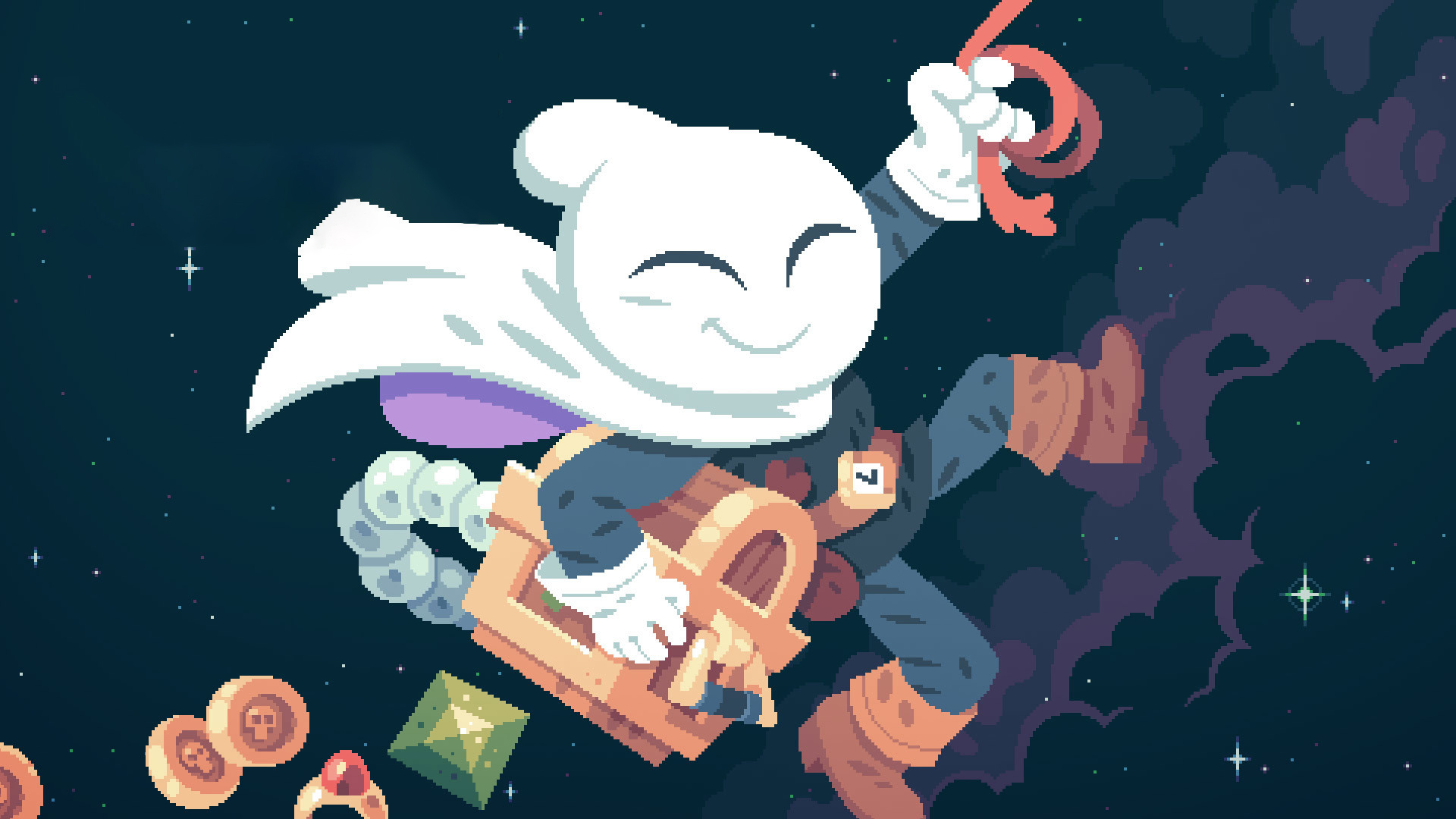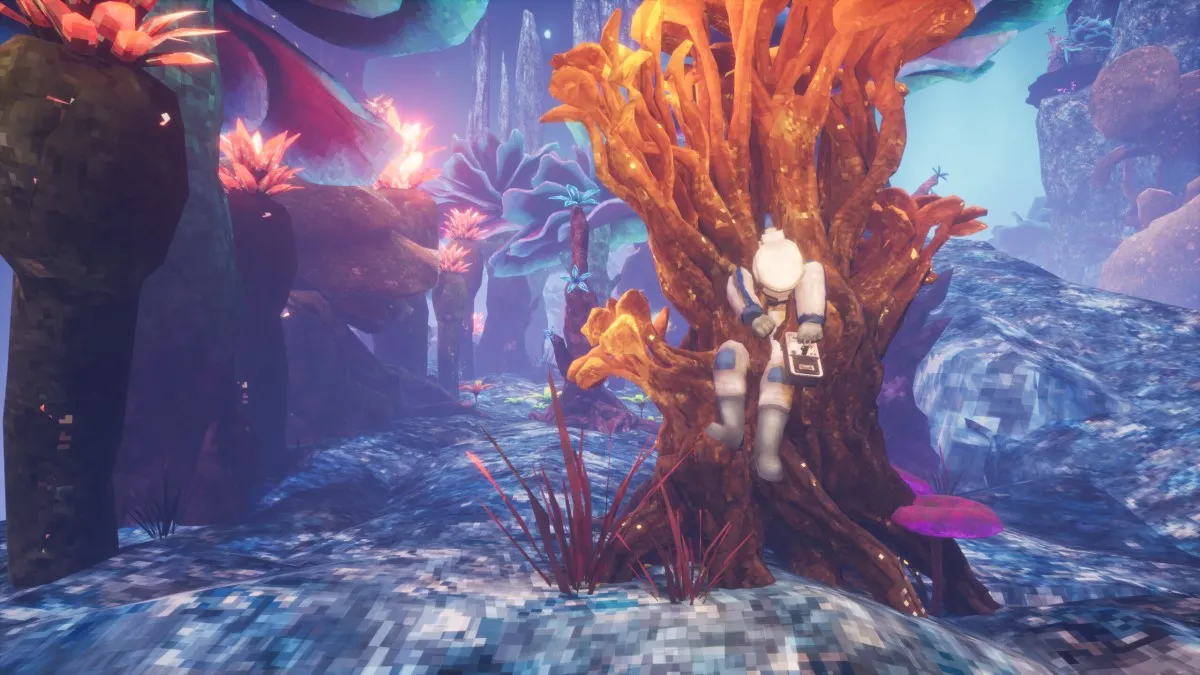The best time I’ve had hookin’ since college
One part ghost, one part pirate, one part bounty hunter, one part hooker. No, I’m not talking about your grandma, but the protagonist of Flinthook, a game that had me ‘hooked’ from the start.
Sorry. I had to.

Flinthook (PC [reviewed], PS4, Xbox One)
Developer: Tribute Games
Publisher: Tribute Games
Released: April 18, 2017
MSRP: $14.99
On paper, Flinthook sounds like a formula that has been done to death (at least on Steam): a rogue-lite platformer with pixelated graphics and randomly generated maps. However, execution is everything, and Tribute Games has mostly nailed it from the wonderful intro laced with one of the most exciting chiptunes I’ve heard, to the long and difficult final bounty.
So check it: you’re Mister Flinthook, a ghost that possesses a humanoid form which dawns an anchor that is used as a grappling hook. You’re also a space pirate, which makes sense as each map is a different ship you board by blasting through on the giant anchor that your ship uses to propel itself through space. While I’m not quite sure what your end goal is, you set out to fulfill bounties by tracking down four different fugitives, each requiring you complete more ships than the last.
Captain Flinthook is armed with a basic gun that shoots plasma balls in any direction around himself, and a grappling anchor that can also be used in any direction. While the game is fully playable with a controller, movement and aim are mapped to the left stick with seemingly no way to change it. This is in contrast to playing with a keyboard and mouse where the mouse controls your aim independent of the direction of your movement. That said, both control schemes are serviceable, though being able to aim with the right stick would have been appreciated and made the two options feel a bit more on par. You can also momentarily slow down time, which is useful when there are many enemies and bullets to avoid. Apparently, there is also an evade button, according to the game’s options menu, but I couldn’t seem to get it to do anything on either control method. Weird.
Regardless of control discrepancies, I found the control scheme easy to pick up, and natural. The hook can be used to quickly move around via latching onto golden rings strewn about each room. Many times the use of these rings isn’t optional as entire rooms will have no safe points to stand, but no worries, there are no one-hit kills in this game and health can be extended over time.
Health isn’t the only thing that can be upgraded; your gun, hook, movement speed, and various consumable sub weapons can be as well. Upgrades are found in chests and on ship shops using gold, unlocked via packs earned by leveling your character from gold, or purchased from the black market on the main menu via special black market coins found in chests throughout each map. Upgrades come in the form of equippable perks of which you can only use so many at a time based on the number of points you have unlocked to do so. You can also buy more perk points in the black market. While there are a ton of different perks to unlock, I never found many of them all that useful aside from having my bullets go a bit further and extra health.
Flinthook isn’t particularly difficult, but that could be thanks to me putting nearly all of my perk points towards health when available. During the last bounty, I believe I was able to be hit close to 20 times before dying. But without taking my health addiction into consideration, I found most of the enemies pushovers. Heck, most of the ones you find on the first bounty simply float in the air not attacking, and die in one hit, which isn’t a great impression to start out with. Thankfully the further you go on the harder the game gets as it introduces stronger and more difficult enemies. The bosses are where the real challenge lies, but the game makes sure you’re ready for them since they each have attacks that are similar to lesser enemies found throughout the ships that proceed them.
The flow of the game is pretty simple: choose a bounty of the four unlockable, complete the required number of ships, fight the boss. Each ship acts as its own randomly generated standalone map. These maps are made up of shops, obstacles, rewards, secrets, and rooms where you’re locked in until you kill all the enemies that spawn, awarding you a chest accompanied by a pleasant sound effect; a small touch that makes getting them rewarding till the end. Chests mostly contain gold to spend at shops on board or food to heal you, and they can also be found tucked away behind spikes and other obstacles in certain rooms, just begging you to try to get them.

The actual maps themselves are mostly laid out in a sort of linear way in that there is one path to the end with side rooms that are shops or chest rooms. Once I figured this out I’d step through doorways in each direction off of each room to see what kind of room it was, as most of the time if it had another exit, it meant it was the path to the end. If not, it probably had a chest or shop in it. This process wasn’t exactly fun, but more so tedious, since it otherwise meant backtracking through each ship to check rooms I’d passed by, although I’m not sure how it could have been designed better. I suppose I preferred that to the ships with the labyrinth modifier that meant there was no obvious direct patch to the end.
Between each ship, you’re given a selection to choose from, each marked with different modifiers. Modifiers include things like the aforementioned labyrinth layout, but also infestations of certain enemies, low gravity, curses, and the kinds of shops or collectible items you’ll find on board. There are a couple different collectible items to find, pages that give you the lore behind an item or character, and relics which appear to serve no purpose, although I’m sure there is some hidden meaning behind them.
As far as lore and story goes, there isn’t a lot here, at least on the surface. No new story is revealed between levels aside from the intro of the game, the intro of the final bounty, and the ending. The lore pages, while interesting, do little more than give you background on characters and locations. Of course, I’m missing a majority of both lore and relics, so perhaps there is more to it than I’m seeing after ranking up to level 41 after 13 hours of gameplay, which was how long I needed to finally complete all the vanilla levels one time.
I say “vanilla” levels because hard versions are unlockable from the black market, which probably offer the challenge I wish the rest of the game had. Unfortunately, these harder variations cost a lot of black market coins, meaning you’ll have to grind the easier levels to buy them. That seems counter-intuitive, in that it may burn out the more skilled players before they ever even unlock them. As a rogue-lite with randomly generated maps made up of what is most likely hundreds of different room selections, I don’t see enough variety for most people to want to keep playing after they finish the final bounty. While I thoroughly enjoyed my time with Flinthook, I just don’t see a reason to play more, personally. Those wanting to figure out more lore or unlock every item and perk will get a bit more mileage than my 13 hours.

Aside from gameplay, I love this soundtrack. Tracks match the tone and settings perfectly and reminded me a great deal of Danny Baranowsky’s work for Crypt of the NecroDancer. I was actually surprised that it wasn’t him behind this score, which should be a huge compliment to Flinthook‘s composer as I consider Danny one of the best. I especially loved the game’s intro theme and the tutorial level that sounds exactly what I’d picture a space pirate’s life should sound like. Also like Crypt of the NecroDancer, the shops each have their own tunes that are just delightful, although they lack any vocal tracks.
This is going to sound stupid, but I think my favorite part of Flinthook is breaking stuff. Each ship is littered with bottles, boxes, and other breakable materials that almost always contain gold when shot and destroyed. I’ve always loved breaking stuff in games, ever since the light gun game Area 51 let me do so. I guess you could say I’m the Fred Durst of video games…because I like breaking stuff. Get it? I’m all about that he said, she said bullshit.
Flinthook is a fine video game that sunk its hooks into me with easy to pick up and play gameplay, a catchy soundtrack, and cute characters. It’s easily a recommendable rogue-lite for any fans of the genre or platformers in general. Just don’t expect the game to anchor you to your seat unless you’re the kind of person that needs to uncover every piece of treasure possible. Even if you aren’t, Flinthook is a dandy game, in space.
[This review is based on a retail build of the game provided by the publisher.]





